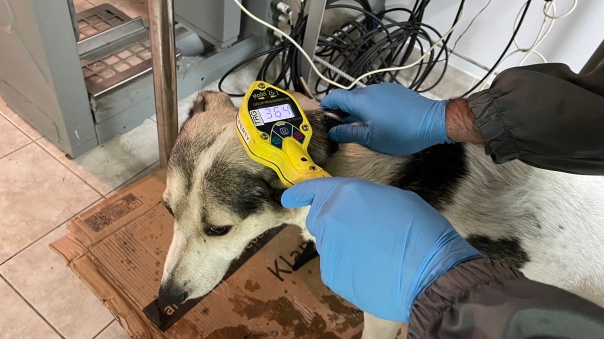The Dogs of Chernobyl

A mother dog and her puppies at the Chornobyl nuclear power plant. (Photo: Tim Mousseau / CFF+ © 2020)
Pity the poor dogs (and cats) of Chornobyl. Abandoned in 1986 by owners fleeing the nuclear disaster, their descendants live on in the Chornobyl Exclusion Zone, an area deemed too radioactive for human habitation and in a country now at war.
Shortly after the 1986 nuclear accident, that saw Chornobyl unit 4 explode and spew deadly radioactive fallout across the former Soviet Union and Western Europe, Soviet authorities made an effort to cull the abandoned pets. (For animal lovers who watched the Sky/HBO drama series, “Chernobyl”, this was a particularly disturbing episode.)
Now, Chornobyl’s hapless lost dogs and cats find themselves living in a war zone as well. Russian troops marched into the Exclusion Zone at the very start of the invasion, in late February 2022, and occupied the Chornobyl power plant site by force. When they moved on, they left behind churned up topsoil that disturbed radioactive fallout and increased radiation levels in the area. As the war drags on, it is impossible to predict whether the Russian troops will be back.
The presence today of at least several hundred semi-feral domestic dogs living around the Chornobyl plant and beyond, indicates that the 1986 cull was not, of course, entirely successful. The Dogs of Chornobyl — and their more furtive feline friends — continue to survive down the generations in a highly radioactive environment. There are other threats too, including exposure to rabies and wolf packs that prey on the dogs and their puppies.
The workforce that had until the start of the war traveled to and from the Chornobyl site each day, had taken to feeding them. A charity, the Clean Futures Fund, has implemented a sterilization program to try to limit breeding. “It is interesting to note that there are next to no mature animals (over 6-8 years old) at the plant, and most of the dogs appear to be under 4-5 years old,” the Fund notes on its website. “There are estimated to be over 700 dogs and 100 cats that reside in the zone at any one given time.”
So how are these animals surviving? And how well?
A new study, — The dogs of Chernobyl: Demographic insights into populations inhabiting the nuclear exclusion zone — published in the journal, Science Advances, has not yet answered this fundamental question. But the researchers have been able to gather important data to enable that next step.

The Chornobyl dogs that are part of the new study are fed by plant workers while the Clean Futures Fund attends to their medical and nutritional needs. (Photo: Tim Mousseau / CFF+ © 2020)
The group studied the DNA of three sets of dog populations: those living at the Chornobyl power plant itself; those around nine miles away in Chornobyl City and another group around 28 miles away in Slavutych.
Their task was made easier by a surprising discovery: the dogs were not living in the traditional manner of wild dogs, or their closest ancestor, the Grey Wolf, but in distinct family units.
“Consistent with previous studies, our findings highlight the tendency of semi-feral dogs, much like their wild canid ancestors, to form packs of related individuals,” the authors wrote in the Discussion section of their paper. “However, our findings also reveal that within this region, small family groups or packs of free-roaming dogs coexist in close proximity to each other, a phenomenon at odds with the generally territorial nature of domestic dog’s closest ancestor, the gray wolf.”
These distinct family groups and lack of intermingling meant the researchers could easily identify different dogs through their DNA and thus distinguish those living at the nuclear plant from those living further away.
“We know who’s related to who,” one of the authors, Elaine Ostrander, a geneticist at the National Human Genome Research Institute, told Science News.

A dog under examination for radiation as part of the demographic study of Chornobyl dogs. (Photo: Clean Futures Fund)
Co-author Tim Mousseau, professor of biological sciences at the University of South Carolina, has been visiting the Chornobyl site and studying the fate of its wildlife there since the late 1990s. At the same time, he began collecting blood samples from the Chornobyl dogs, curious to know how their bodies were handling such a significant radioactive load. Those samples are now being used in the current study to examine the dogs’ DNA. Wrote the authors in their paper:
“Hence, the dogs of Chernobyl are of immense scientific relevance for understanding the impact of harsh environmental conditions on wildlife and humans alike, particularly the genetic health effects of exposure to long-term, low-dose ionizing radiation and other contaminants, i.e., their adaptation to harsh living conditions makes them an ideal system in which to identify mutational signatures resulting from historical and ongoing radiation exposures.”
Mousseau’s wildlife studies have revealed shortened lifespans among birds and small mammals as well as the prevalence of tumors, sterility and cataracts among other phenomena considered related to exposure to radiation.
How or if the DNA of the Chornobyl-affected dogs has altered can now be examined. Whereas the researchers do not yet know whether radiation exposure in particular has caused changes to the dogs’ DNA, they have the luxury of being able to compare them as a distinct group from other feral dog communities. As Mousseau described it to the Associated Press, the Chornobyl dogs “provide an incredible tool to look at the impacts of this kind of a setting”.
This in turn may lead to enlightenment on whether or not radiation damage is accumulating in their genomes and how this may affect their health and longevity — and that of other mammals similarly exposed — now and into the future.
This originally appeared in Beyond Nuclear International.
No comments:
Post a Comment